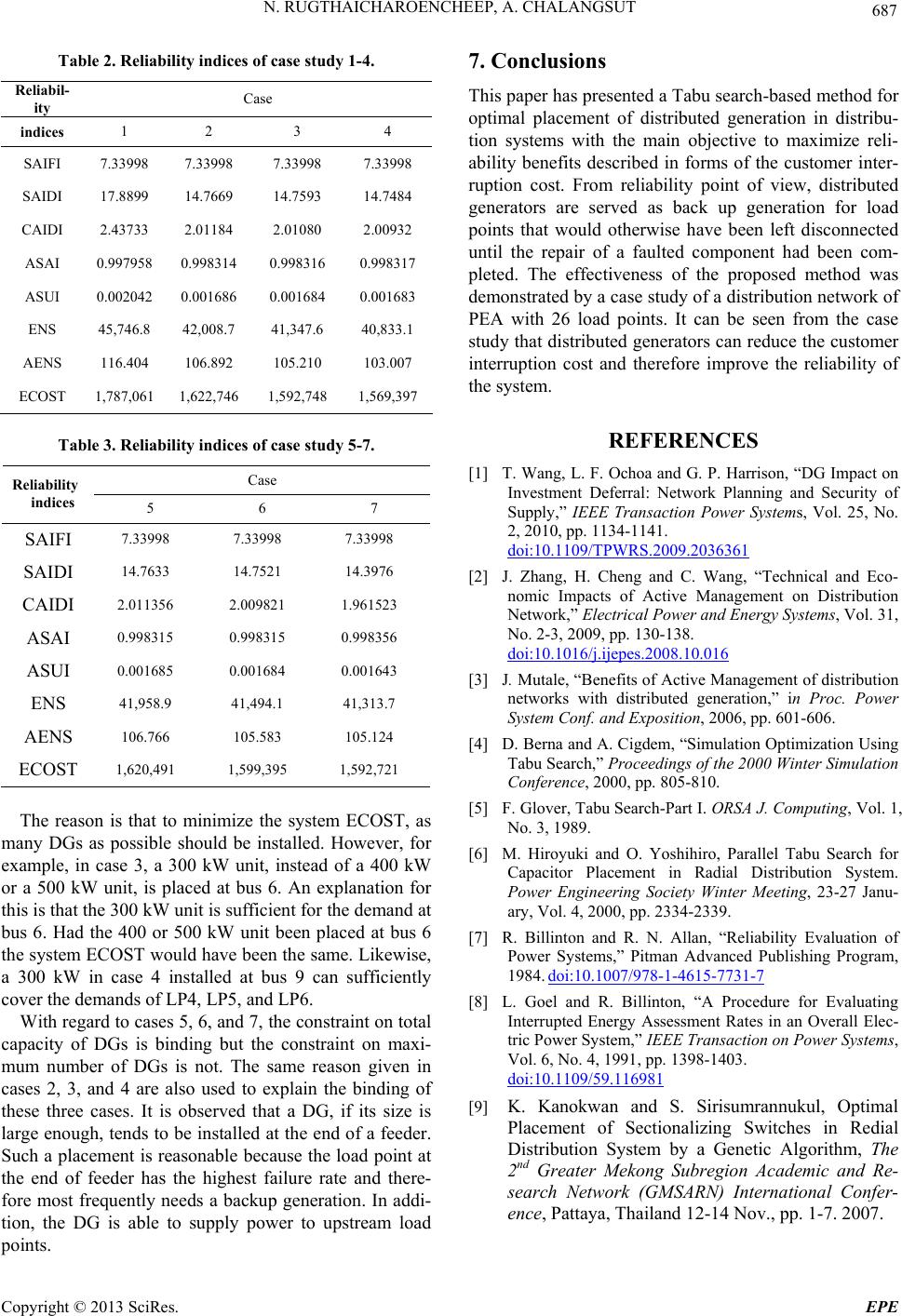
N. RUGTHAICHAROENCHEEP, A. CHALANGSUT 687
Table 2. Reliability indices of case study 1-4.
Reliabil-
ity Case
indices 1 2 3 4
SAIFI 7.33998 7.33998 7.33998 7.33998
SAIDI 17.8899 14.7669 14.7593 14.7484
CAIDI 2.43733 2.01184 2.01080 2.00932
ASAI 0.997958 0.998314 0.998316 0.998317
ASUI 0.002042 0.001686 0.001684 0.001683
ENS 45,746.8 42,008.7 41,347.6 40,833.1
AENS 116.404 106.892 105.210 103.007
ECOST 1,787,061 1,622,746 1,592,748 1,569,397
Table 3. Reliability indices of case study 5-7.
Case
Reliability
indices 5 6 7
SAIFI 7.33998 7.33998 7.33998
SAIDI 14.7633 14.7521 14.3976
CAIDI 2.011356 2.009821 1.961523
ASAI 0.998315 0.998315 0.998356
ASUI 0.001685 0.001684 0.001643
ENS 41,958.9 41,494.1 41,313.7
AENS 106.766 105.583 105.124
ECOST 1,620,491 1,599,395 1,592,721
The reason is that to minimize the system ECOST, as
many DGs as possible should be installed. However, for
example, in case 3, a 300 kW unit, instead of a 400 kW
or a 500 kW unit, is placed at bus 6. An explanation for
this is that the 300 kW unit is sufficient for the demand at
bus 6. Had the 400 or 500 kW unit been placed at bus 6
the system ECOST would have been the same. Likewise,
a 300 kW in case 4 installed at bus 9 can sufficiently
cover the demands of LP4, LP5, and LP6.
With regard to cases 5, 6, and 7, the constraint on total
capacity of DGs is binding but the constraint on maxi-
mum number of DGs is not. The same reason given in
cases 2, 3, and 4 are also used to explain the binding of
these three cases. It is observed that a DG, if its size is
large enough, tends to be installed at the end of a feeder.
Such a placement is reasonable because the load point at
the end of feeder has the highest failure rate and there-
fore most frequently needs a backup generation. In addi-
tion, the DG is able to supply power to upstream load
points.
7. Conclusions
This paper has presented a Tabu search-based method for
optimal placement of distributed generation in distribu-
tion systems with the main objective to maximize reli-
ability benefits described in forms of the customer inter-
ruption cost. From reliability point of view, distributed
generators are served as back up generation for load
points that would otherwise have been left disconnected
until the repair of a faulted component had been com-
pleted. The effectiveness of the proposed method was
demonstrated by a case study of a distribution network of
PEA with 26 load points. It can be seen from the case
study that distributed generators can reduce the customer
interruption cost and therefore improve the reliability of
the system.
REFERENCES
[1] T. Wang, L. F. Ochoa and G. P. Harrison, “DG Impact on
Investment Deferral: Network Planning and Security of
Supply,” IEEE Transaction Power Systems, Vol. 25, No.
2, 2010, pp. 1134-1141.
doi:10.1109/TPWRS.2009.2036361
[2] J. Zhang, H. Cheng and C. Wang, “Technical and Eco-
nomic Impacts of Active Management on Distribution
Network,” Electrical Power and Energy Systems, Vol. 31,
No. 2-3, 2009, pp. 130-138.
doi:10.1016/j.ijepes.2008.10.016
[3] J. Mutale, “Benefits of Active Management of distribution
networks with distributed generation,” in Proc. Power
System Conf. and Exposition, 2006, pp. 601-606.
[4] D. Berna and A. Cigdem, “Simulation Optimization Using
Tabu Search,” Proceedings of the 2000 Winter Simulation
Conference, 2000, pp. 805-810.
[5] F. Glover, Tabu Search-Part I. ORSA J. Computing, Vol. 1,
No. 3, 1989.
[6] M. Hiroyuki and O. Yoshihiro, Parallel Tabu Search for
Capacitor Placement in Radial Distribution System.
Power Engineering Society Winter Meeting, 23-27 Janu-
ary, Vol. 4, 2000, pp. 2334-2339.
[7] R. Billinton and R. N. Allan, “Reliability Evaluation of
Power Systems,” Pitman Advanced Publishing Program,
1984. doi:10.1007/978-1-4615-7731-7
[8] L. Goel and R. Billinton, “A Procedure for Evaluating
Interrupted Energy Assessment Rates in an Overall Elec-
tric Power System,” IEEE Transaction on Power Systems,
Vol. 6, No. 4, 1991, pp. 1398-1403.
doi:10.1109/59.116981
[9] K. Kanokwan and S. Sirisumrannukul, Optimal
Placement of Sectionalizing Switches in Redial
Distribution System by a Genetic Algorithm, The
2nd Greater Mekong Subregion Academic and Re-
search Network (GMSARN) International Confer-
ence, Pattaya, Thailand 12-14 Nov., pp. 1-7. 2007.
Copyright © 2013 SciRes. EPE